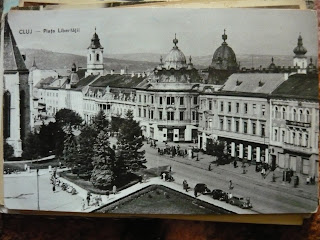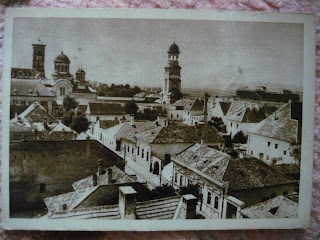Postcards offered for swap for postcards, stamps, coins etc. for details email me: c.z2012@yahoo.com or vintagecards2012@gmail.com
Sunday, January 6, 2013
Cluj Napoca- "Gh. Dimitrov" Square
1958 card. Sent without a stamp with a "for pay" seal. You can see in the picture the Carolina Obelisk and the Franciscan church. The square is called now :Museum Square
The “Carolina” Obelisk (The Museum Square) is the oldest lay monument of the city. The statue is a commemorative column, set up to commemorate the visit of the Emperor Francis the First and his wife Carolina Augusta, between 18th and 27th of August 1817. The Emperor attended the ceremony, celebrating the Day of Saint Stephan, (August 20th), chaired the meeting and visited the City Hospital.
In order to build the statue, the Emperor's approval was necessary and funding was raised among the inhabitants of Cluj, but the statue was finished thanks to the financial help of the city District Attorney, Topler Imre. It was inaugurated on the 4th of October 1831, on Saint Francis’s Day.
The ten meter obelisk, the angel wearing the effigy in a crown of laurels and the four stone eagles that hold laurels in their peaks are a masterpiece of Anton Csürös and Nagy Samuel.
Carolina Augusta offered the Hospital from Museum Square a donation and starting with 1818 the hospital bore the name Carolina Hospital, and was destroyed in 1914.
The Carolina Obelisk was initially placed in what is now known as Union Square (the old Great Square). In 1898, during the city restructuring, it was moved to the Museum Square (the old Small Square).
Cave Church on Gellert Hill Budapest
Located on Gellert Hill overlooking Liberty Bridge (Szabadsaq Hid) in Budapest, the Cave Church is a unique grotto chapel cared for by the Hungarian Paulite order of monks. Closed during the Communist years, it has since been reopened and offers a peaceful respite from the noise of the city.
This cave on Gellert Hill was originally home to Saint Istvan, a hermit monk who cured the sick with thermal waters that sprung in front of the cave.
The Cave Church was founded in 1926 by expanding the hermit's cave. The church was further enlarged in the 1930s by the Archbishop of Kalocsa to hold more worshippers, using the grotto at Lourdes as a model.
In 1951, the Communist secret police arrested the entire order of Pauline monks. The superior Ferenc Vezer was condemned to death, while the others received 5- to 10-year prison sentences. The chapel was blocked up with a 2.25m thick concrete wall, behind which it stood silent for nearly 40 years.
After the fall of Communism in 1989, the Cave Church was returned to the Paulite order and immediately reopened.
(http://www.sacred-destinations.com )
Unused card. I guess it's around 1930s.
This cave on Gellert Hill was originally home to Saint Istvan, a hermit monk who cured the sick with thermal waters that sprung in front of the cave.
The Cave Church was founded in 1926 by expanding the hermit's cave. The church was further enlarged in the 1930s by the Archbishop of Kalocsa to hold more worshippers, using the grotto at Lourdes as a model.
In 1951, the Communist secret police arrested the entire order of Pauline monks. The superior Ferenc Vezer was condemned to death, while the others received 5- to 10-year prison sentences. The chapel was blocked up with a 2.25m thick concrete wall, behind which it stood silent for nearly 40 years.
After the fall of Communism in 1989, the Cave Church was returned to the Paulite order and immediately reopened.
(http://www.sacred-destinations.com )
Unused card. I guess it's around 1930s.
Genovese Lighthouse
Used card. Sent in the mid 1990s. Both stamps on the back intact.
The lighthouse in placed in Constanta(Romanian city at the Black Sea).
It is 8 m high and it was built around 1300 and restored between 1858-1860 by the French-Armenian engineer Artin Aslan.
Saturday, January 5, 2013
Old Woman's Gorges
Used card. 1975. Pre-stamped.
The Old Woman's Gorges is a natural reserve(of geological type) since 1977
Borsec
One famous visitor to Borsec was Moldavian writer Vasile Alecsandri, who wrote the following in 1845: "at Borsec they all are brothers, if not in Jesus then in mineral water [...] one of the most important merits of Borsec is that it gives people human feelings!"
1967 written and stamped card.
Alba Iulia views
Alba Iulia (Hungarian: Gyulafehérvár, German: Karlsburg or Weißenburg, Latin: Apulum in the Roman period, later Alba Iulia; Ottoman Turkish: Erdel Belgradı) is a city in Alba County, Transylvania, Romania with a population of 58,681, located on the Mureş River. Since the High Middle Ages, the city has been the seat of Transylvania's Roman Catholic diocese. Between 1541 and 1690 it was the capital of the Eastern Hungarian Kingdom and the latter Principality of Transylvania. Alba Iulia is historically important for Romanians, Hungarians and Transylvanian Saxons.
Fortress' walls. 1958 used card. Written and stamped.
The main historical area of Alba Iulia is the Upper Town region, developed by Charles VI of the Holy Roman Empire in honour of whom the Habsburgs renamed the city Karlsburg. The fortress, with seven bastions in a stellar shape, was constructed between 1716 and 1735, by two fortification architects of Swiss origin. The first one was Giovanni Morandi Visconti, who constructed two old Italian stile bastions, followed by Nicolaus Doxat de Demoret, nicknamed "Austrian Vauban". The two architects radically transformed (after 1720) the medieval fortress shaped by the former Roman Castrum into a seven-bastion baroque fortress, developing Menno van Coehorn's new Dutch system, of which the fortress of Alba Iulia is the best preserved example.
Balaton Lake
Labels:
Balaton,
Boat,
Hungary,
Map,
postcard for swap,
postcrossing
Thursday, January 3, 2013
Ciprian Porumbescu's memorial house
1970s postcard. Not used.
The memorial house from Stupca of the Romanian composer Ciprian Porumbescu
Targu Mures- aerial views
New card for swap.
The second air view is from 1967 and shows the downtown. Used card, missing stamp.
The second air view is from 1967 and shows the downtown. Used card, missing stamp.
Callatis- Ancient Ruins
Used card(broken stamp) sent in 1973.
Ruins of the Greek city Callatis(VI B.C-VII A.D), at the Black Sea, on Romanian side.
Wednesday, January 2, 2013
Tuesday, January 1, 2013
Subscribe to:
Comments (Atom)



















































